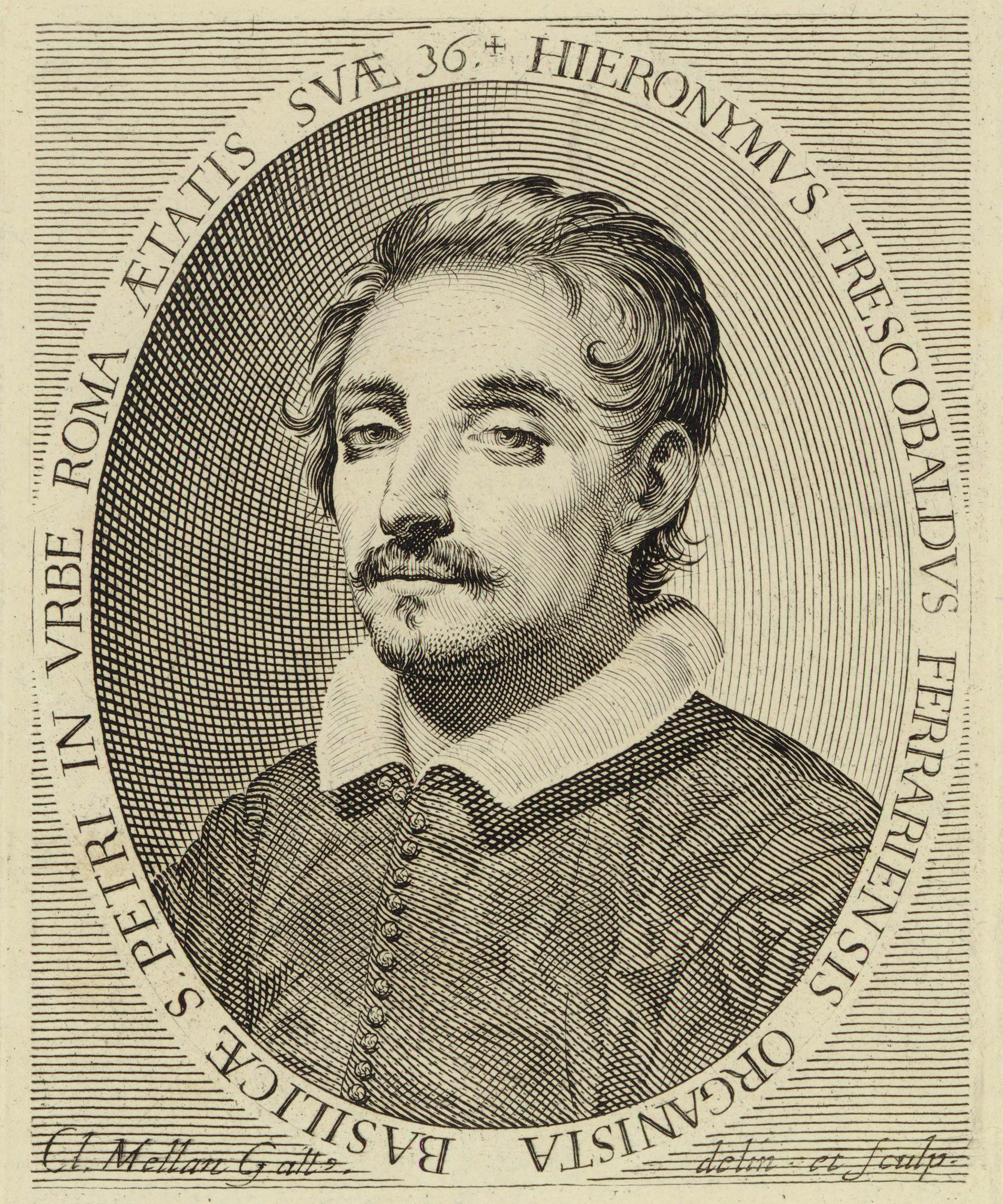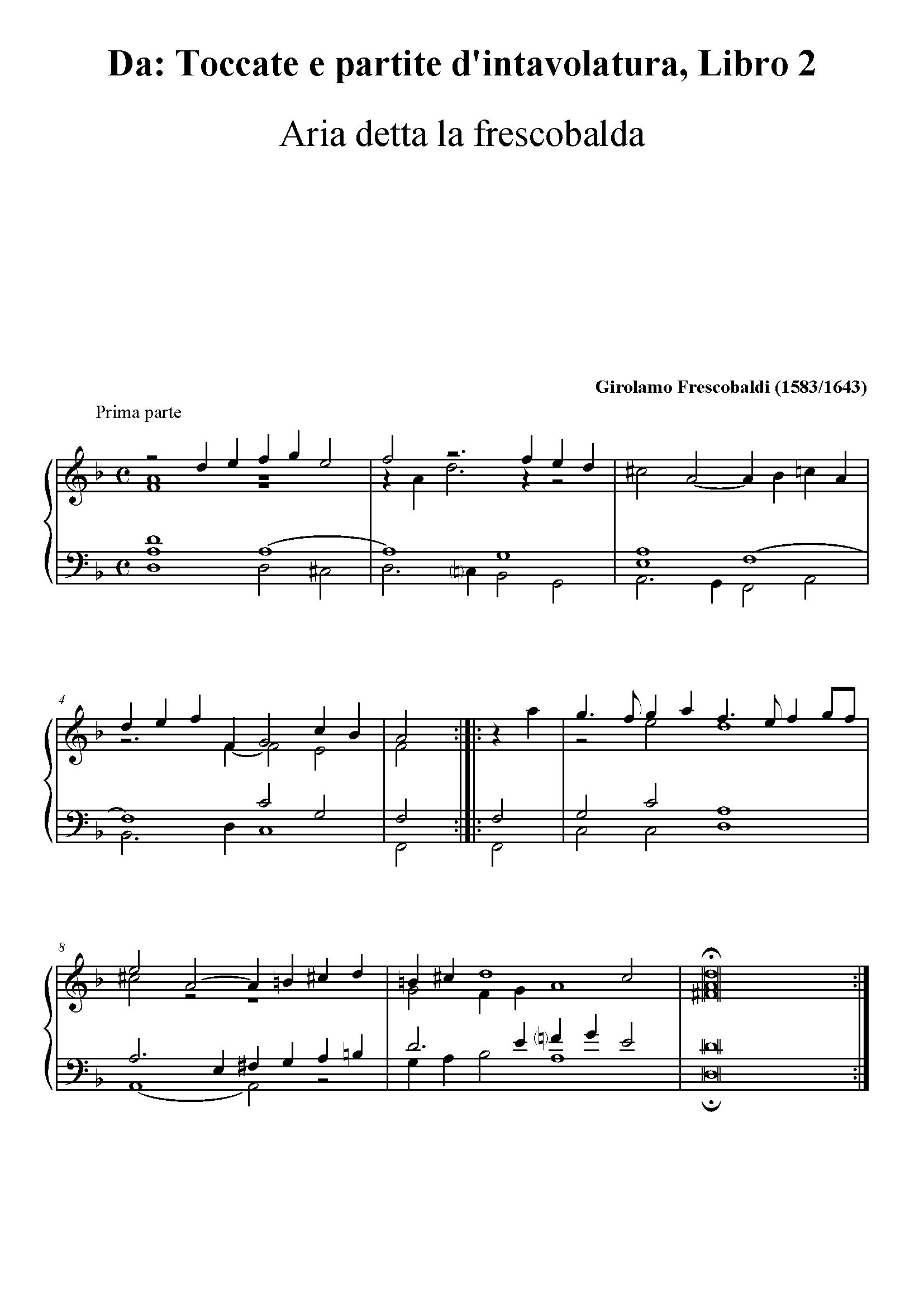La Frescobalda F 3.32

Frescobaldi, Girolamo
(1583 - 1643)
"Aria detta la frescobalda"
[Aria called "la frescobalda"]
Aria with variations F 3.32
| Aria detta la frescobalda - Aria with variations F 3.32 [Aria called "la frescobalda"] |
|||||
| Piano: Tullio Forlenza |
|||||
|
You can purchase these recordings in HD quality (192.000 Hz 24 bit) |
|||||
 |
|||||
To consult different editions of this work go to:
GIROLAMO FRESCOBALDI - Aria detta la frescobalda F 3.32 IMSLP
or to:
GIROLAMO FRESCOBALDI - Toccate e partite d'intavolatura, Libro 2
HISTORICAL NOTES
The "aria detta la frescobalda" [the aria called la frescobalda] appeared for the first time in 1627 in a publication by Nicolò Bordone titled:
"IL SECONDO LIBRO DI TOCCATE CANZONE VERSI D'HINNI MAGNIFICAT GAGLIARDE CORRENTI ET ALTRE PARTITE D'INTAVOLATURA DI CIMBALO ET ORGANO DI GIROLAMO FRESCOBALDI ORGANISTA IN S. PIETRO DI ROMA"
[The second book of toccatas, songs, hymns, magnificat, galliards, courantes et other tablature for harpsichord and organ by Girolmamo Frescobaldi, organist in S. Peter in Rome]
The publication was reprinted by the same publisher as early as 1637.
The piece became famous thanks to the guitar transcription made by Andrés Segovia and published in 1939 by Schott Music. This transcription was very successful and was initially widely spread especially among guitarists.
Andrés Segovia introduced his version of the 'frescobalda' for the first time in Italy during a concert organized by the IUC (University Concert Organization) in Rome on the 30th of November 1960.
Meanwhile, in 1952, the italian publisher Ricordi had published a piano version of the piece, almost identical to the organ version, except for some minor discrepancies due to a more tonal interpretation of the frescobaldian writing.
(Thanks to M° Giuliano Balestra and M° Mario D'Agosto for the precious information on Andrés Segovia)
CHARACTERISTICS OF THE PIECE
Thisi is a very well-known piece of undoubted interest from different points of view, the first important characteristic is that this is the first known example of "variations on an original theme"
Until that time the art of variation had always been linked to the use of popular or already known melodies. Before the publishing of this piece, there is no news of a composer who had written a theme of his own, just for the sake of changing it.
The name "frescobalda" probably comes from this peculiar characteristic, meaning therefore: an aria composed by Frescobaldi himself.
The second interesting feature consists in the mixture of variations with different characters: some with a polyphonic structure, others in dance movement, thus giving rise to a mixture between the variation and the suite.
The parts of this piece are five, thus signed by the composer himself:
| First part | (Aria) | ||
| Second part |
(Variation) | ||
| Third part | Gagliarda | [Gaillarde] | |
| Fourth part | (Variazione) | ||
| Fifth parte | Corrente | Courante | |
PERFORMANCE NOTES
The choices to make when dealing with a piece such as the "aria called la frescobalda" concern many aspects of the art of piano playing; in the first place we must consider that this piece was not conceived for the piano, but for the organ and therefore we will never be able to produce a valid imitation with our instrument, even though we must always take into consideration the original sounds for which the piece was intended.
In second place, the other important aspect concerns the knowledge of Renaissance and Baroque dances, which must be used as a fundamental basis when choosing speeds and dynamics.
In the piece there are also melodic and polyphonic sections in which we must prioritize the comprehensibility and the cantabile, both so dear to Frescobaldi composer and keyboardist.
Having said that, in the initial air I tried to bring out not only the cantabile mood but also the rhythmic tension that appears in the theme, only just hinted, to highlight the double nature of the variations that follow.
I chose to play the first of these variations in moderate time and with a certain softness of sound, that should allow an easy comprehension of the counterpoints.
Then I thought of performing the second variation, that is the first of the two dances, in a faster moving time and with a strong rhythmic character, as indicated in the various descriptions of the Gaillard. These descriptions underline the presence of real dancer's jumps to take place at the links between the different bars.
Still a moderate movement, but slightly smoother for the third variation, of melodic and polyphonic character, this time with some rallentando in the phrase closings, compatibly with the frescobaldian rules for the performance of his compositions as reported below.
The last variation and second dance is a current of the French type, to which I wished to give again a distinctly rhythmic, smooth and decisive character.
The Last personal choice, considering the organistic origin of the piece, was to place this performance in a wide acoustic ambience, to guarantee the support and duration of the different harmonies that alternate during the piece.
Tullio Forlenza
(Trad.: Ilaria Barborini)
